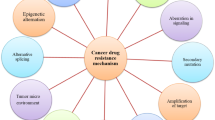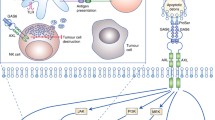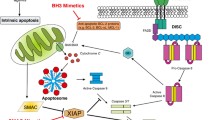Abstract
For many years the main strategies in the development of anticancer drugs were focused on killing tumour cells by means of agents which are blockers of transcription or translocation. However, it is evident that the currently available anticancer drugs, mainly antimetabolites and alkylating agents, cannot cure the most common types of cancer in adults. Therefore, totally new approaches are necessary in cancer chemotherapy research; one of these is disturbing cell signalling pathways involved in growth and malignant transformation. Several studies have concentrated on mechanisms of cell growth and differentiation, control through growth factor receptors and their ligands, oncogenes, proto-oncogenes and other membrane-associated signalling mechanisms. This paper discusses the potential targets in these signalling pathways for novel anticancer drugs.
Similar content being viewed by others
References
Wilson JD, Braunwald E, Isselbacher KJ, Petersdorf RG, Martin JB, Fauci AS, et al. Harisson's principles of internal medicine part I, section II, Cell growth and regulation. 12th edition, New York: McGraw-Hill, 1991:60–73.
Grunicke H. Metabolic control in cancer. Signal transduction mechanisms in cancer. Biochem Soc Trans 1990;18:67–9.
Pastan I, Fitzgerald D. Recombinant toxins for cancer treatment. Science 1991;254:1173–7.
Perry MC, editor. The chemotherapy source book. Baltimore: Williams & Wilkins, 1992.
Berger MR, Richter H, Seelig MH, Eibl H, Schmahl D. New cytostatics-more activity and less toxicity. Cancer Treat Rev 1990;17:143–54.
Liebow C, Lee MT, Schally A. Antitumour effects of somatostatin mediated by the stimulation of tyrosine phosphatase. Metabolism 1990;39 Suppl 2:163–6.
Alberts B, Bray D, Lewis J, Raff M, Roberts K, Watson JD. Molecular biology of the cell. 2nd ed. New York: Garland Publishing, 1989.
Aaronson SA. Growth factors and cancer. Science 1991;254:1146–53.
Sorrentino V. Growth factors, growth inhibitors and cell cycle control. Anticancer Res 1989;9:1925–36.
Goustin AS, Leof EB, Shipley GD, Moses HL. Growth factors and cancer. Cancer Res 1986;46:1015–29.
Moolenaar WH, Tertoolen LGJ, De Laat SW. Growth factors immediately raise cytoplasmic free Ca2+ in human fibroblasts. J Biol Chem 1984;259:8066–9.
Rozengurt E. Stimulation of Na+ influx, Na+/K+ pump activity and DNA synthesis in quiescent cultured cells. Adv Enzyme Regul 1981;19:61–85.
Diamond I, Legg A, Schneider JA, Rozengurt E. Glycolysis in quiescent cultures of 3T3 cells. J Biol Chem 1978;253:866–71.
Bell RM. Protein kinase C activation by diacylglycerol second messengers. Cell 1986;45:631–2.
Carpenter G. Epidermal growth factor. Annu Rev Biochem 1979;48:193–216.
Kawamoto TJ, Sato JD, Le A, Polikoff T, Sato GH, Mendelsohn J. Growth stimulation of A431 cells by epidermal growth factor: identification of high affinity receptors for EGF by an antireceptor monoclonal antibody. Proc Natl Acad Sci USA 1983;80:1337–41.
Roberts AB, Sporn MB. Principles of molecular cell biology of cancer: growth factors related to transformations. In: Devita VT, Hellman S, Rosenberg SA, editors. Cancer: principles and practice of oncology. 3rd ed. Philadelphia: J.B. Lippincott, 1990:67–78.
Moody TW, Pert CB, Gazdar AF, Carney DN, Minna JD. High levels of intracellular bombesin characterize human small cell lung carcinoma. Science 1981;214:1246–8.
Wood S, Wood J, Ghatei M, Lee U, O'Shaghnessy D, Bloom S. Bombesin, somatostatin, and neurotensin-like immunoreactivity in bronchial carcinoma. J Clin Endocrinol 1981;53:1310–5.
Erisman MR, Linnoila O, Hernandez R, DiAugustine R, Lazarus L. Human small cell lung carcinoma contains bombesin. Proc Natl Acad Sci USA 1982;79:2379–83.
Yamaguchi K, Abe K, Kameya T, Adachi I, Taguchi S, Otsubo K, et al. Production and molecular size heterogeneity of immunoreactive gastrin-releasing peptide in fetal and adult lungs and primary lung tumours. Cancer Res 1983;43:3932–9.
Weinstein BI. The origins of human cancer: molecular mechanisms of carcinogenesis and their implications for cancer prevention and treatment. Twenty-seventh G.H.A. Clowes memorial award lecture. Cancer Res 1988;48:4135–43.
Moody TW, Murphy A, Mahmoud S, Fiskum G. Bombesinlike peptides elevate cytosolic calcium in small cell lung cancer cells. Biochem Biophys Res Commun 1987;147:189–5.
Mahmoud S, Staley J, Taylor J, Bogden A, Moreau J, Coy D, et al. [Psi13, 14] Bombesin analogues inhibit growth of small cell lung cancerin vitro andin vivo. Cancer Res 1991;51:1798–802.
Cuttitta F, Carney DN, Mulshine J, Moody TW, Fedorko J, Fischler A, et al. Bombesin-like peptides can function as autocrine growth factors in human small cell lung cancers. Nature 1985;316:823–6.
White MF. Structure and function of tyrosine kinase receptors. J Bioenerg Biomembr 1991;23:63–81.
Songyang Z, Shoelson SE, Chaudhuri M, Gish G, Pawson T, Haser WG, et al. SH2 Domains recognize specific phosphopeptide sequences. Cell 1993;72:767–8.
Waksman G, Shoelson SE, Pant N, Cowburn D, Kuriyan J. Binding of a high affinity phosphotyrosyl peptide to the Src SH2 domain: crystal structures of the complexed and peptide-free forms. Cell 1993;72:779–90.
Yaish P, Gazit A, Gilan C, Levitzki A. Blocking of EGF-dependent cell proliferation by EGF receptor kinase inhibitors. Science 1988;242:933.
Gilman AG. G proteins: transducers of receptor-generated signals. Annu Rev Biochem 1987;56:615–49.
Yip CC. Cell-membrane hormone receptors: some perspectives on their structure and function relationship. Biochem Cell Biol 1988;66:549–56.
Stryer L, Bourne HR. G proteins: a family of signal transducers. Annu Rev Cell Biol 1986;2:391–419.
Neer EJ, Clapham DA. Roles of G protein subunits in transmembrane signalling. Nature 1988;333:129–34.
Lochrie MA, Simon MI. G protein multiplicity in eukaryotic signal transduction systems. Biochemistry 1988;27:4957–65.
Rosenthal W, Hescheler J, Trautivein W, Schultz G. Control of voltage-dependent Ca2+ channels by G protein coupled receptors. FASEB J 1988;2:2784–90.
Akinaga S, Gomi K, Morimoto M, Tamaoki T, Okabe M. Antitumor activity of UCN-01, a selective inhibitor of protein kinase C, in murine and human tumor models. Cancer Res 1991;51:4888–92.
Weinstein IB. Strategies for inhibiting multistage carcinogenesis based on signal transduction pathways. Mutat Res 1988;202:413–20.
Knudson AG. Hereditary cancer, oncogenes and antioncogenes. Cancer Res 1985;45:1437–43.
Nishizuka T. Perspectives and role of protein kinase C in stimulus-response coupling. J Natl Cancer Inst 1986;76:363–70.
Pettit GR, Herald CL, Doubek DL, Herald DL. Isolation and structure of bryostatin 1. J Am Chem Soc 1982;104:6846–9.
Ito M, Tonaka T, Inagaki M, Nakoshini K, Hidaka H. N-(6-phenylhexyl)-5-chloro-1-naphthalenesulfonamide, a novel activator of protein kinase C. Biochemistry 1986;25:4179–84.
Nishino H, Kitagawa K, Iwashima A, Ito M, Tanaka T, Hidaka H. N-(6-phenylhexyl)-5-chloro-1-naphthalenesulfonamide is one of a new class of activators for Ca-activated, phospholipid-dependent protein kinase. Biochim Biophys Acta 1986;889:236–9.
Vogler WR, Whigham E, Bennett WD, Olson AC. Effect of alkyl-lysophospholipids on phosphatidylcholine biosynthesis in leukemic cell lines. Exp Hematol 1985;13:629–33.
Helfman DM, Barnes KC, Kinkade JM, Vogler WR, Shoji M, Kuo JF. Phospholipid-sensitive Ca2+-dependent protein phosphorylation system in various types of leukemic cells from human patients and in human leukemic cell lines HL60 and K562 and its inhibition by alkyllysophospholipid. Cancer Res 1983;43:2955–61.
Joseph SK, Williamson JR. Inositol polyphosphates and intracellular calcium release. Arch Biochem Biophys 1989;273:1–15.
Putney JW, Takemura H, Hughes AR, Horstman DA, Thastrup O. How do inositol phosphates regulate calcium signalling? FASEB J 1989;3:1899–905.
Whitman M, Cantley L. Phosphoinositide metabolism and the control of cell proliferation. Biochim Biophys Acta 1988;948:327–44.
Seewald MJ, Olsen RA, Sehgal I, Melder DC, Modest EJ, Powis G. Inhibition of growth factor-dependent inositol phosphate Ca2+ signalling by antitumor ether lipid analogues. Cancer Res 1990;50:4458–63.
Takahashi I, Kobayashi E, Asano K, Yoshida M, Nakano H. UCN-01, a selective inhibitor of protein kinase C from streptomyces. J Antibiot 1987;40:1782–4.
Takahashi I, Saitoh Y, Yoshida M, Sano H, Nakano H, Morimoto M, et al. UCN-01 and UCN-02, new selective inhibitors of protein kinase C. II. Purification, physiochemical properties, structural determinations, and biological activities. J Antibiot 1989;42:571–6.
Hannun YA, Loomis CR, Merrill AH, Bell RM. Sphingosine inhibition of protein kinase C activity and of phorbol dibutyrate bindingin vitro and in human platelets. J Biol Chem 1986;261:12604–9.
Hannun YA, Bell RM. Lysosphingolipids inhibit protein kinase C: implications for the sphingolipidoses. Science 1987;235:670–4.
Loomis CR, Bell RM. Sangivamycin, a nucleoside analogue, is a potent inhibitor of protein kinase C. J Biol Chem 1988;263:1682–92.
Rotenberg SA, Smiley S, Ueffing M, Krauss RS, Weinstein IB. Inhibition of rodent protein kinase C by the anticarcinoma agent dequalinium. Cancer Res 1990;50:677–85.
Michell RH, Drummond AH, Downes CP. Inositol lipids in cell signalling. London: Academic Press, 1989.
Berridge MJ. Inositol triphosphate and diacylglycerol: two interacting second messengers. Annu Rev Biochem 1987;56:159–94.
Tritton TR, Hickman JA. How to kill cancer cells: membranes and cell signalling as targets in cancer chemotherapy. Cancer Cells 1990;2:95–105.
Jett M, Alving CR. Selective cytotoxicity of tumor cells induced by liposomes containing plant phosphatidylinositol. Biochem Biophys Res Commun 1983;114:863–71.
Parries GS, Hokin-Neaverson M. Inhibition of phosphatidylinositol synthetase and other membrane-associated enzymes by stereoisomers of hexachlorocydohexane. J Biol Chem 1985;260:2687–93.
Moyer JD, Reizes O, Ahir S, Jiang C, Malinowski N, Baker DC. Substrate properties of analogues of myo-inositol. Mol Pharmacol 1988;33:683–9.
Bennett CF, Mong S, Wu HLW, Clark MA, Wheeler L, Cooke ST. Inhibition of phosphoinositide-specific phospholipase C by manoalide. Mol Pharmacol 1987;32:587–93.
Hofman SL, Prescott SM, Majerus PW. The effects of mepacrine andp-bromophenacyl bromide on arachidonic acid release in human platelets. Arch Biochem Biophys 1982;215:237–44.
Best L, Sener A, Mathias PCF, Malaisse WJ. Inhibition by mepacrine andp-bromophen-acylbromide of phosphoinositide hydrolysis, glucose oxidation, calcium uptake and insulin release in rat pancreatic islets. Biochem Pharmacol 1984;33:2657–62.
Berdel WE, Munder PG. Antineoplastic actions of ether lipids related to platelet activating factor. In: Snyder F, editor. Platelet-activating factor and related lipid mediators. New York: Plenum Press, 1987;449–68.
Modest EJ, Noseda A, Daniel LW, Piantodosi C. Membrane targeted ether lipid analogs with antineoplastic activity. Cancer Chemother Pharmacol 1989;24 Suppl:359.
Rasmussen H. The calcium messenger system. New Engl J Med 1986;314:1094–101, 1164–70.
Berridge MJ, Irvine RF. Inositol phosphates and cell signalling. Nature 1989;341:197–205.
Secrist JP, Sehgal I, Olsen R, Powis G, Abraham RT. Selective inhibition of both the PDGF receptor tyrosine kinase and PDGF-dependent phospholipase C activation by staurosporine in Swiss 3T3 cells. J Cell Biochem 1990;Suppl 14b:264.
Bigay J, Deterre P, Pfister C, Chabre M. Fluoride complexes of aluminium orberyllium act on G-proteins as reversibly bound analogues of the gamma-phosphate of GTP. EMBO J 1987;6:2907–15.
Munder PG, Modolell M, Bausert W, Oettgen HF, Wetphal O. Alkyl-lysophospholipids in cancer therapy. In: Hersh EM, editor. Augmenting agents in cancer therapy. New York: Raven Press, 1981:441–52.
Honma Y, Kasukabe T, Hozumi M, Tsushima S, Nomura H. Induction of differentiation of cultured human and mouse myeloid leukaemia cells by alkyl-lysophospholipids. Cancer Res 1981;41:3211–6.
Liebow C, Hierowski M, DuSapin K. Hormonal control of pancreatic cancer growth. Pancreas 1986;1:44–8.
Liebow C, Lee MT, Schally A. Antitumor effects of somatostatin mediated by the stimulation of tyrosine phosphatase. Metabolism 1990;39 Suppl:163–6.
Cho-Chung YS, Clair T, Tortora G, Yokozaki H, Pepe S. Suppression of malignancy targeting the intracellular signal transducing proteins of cAMP: the use of site-selective cAMP analogs, antisense strategy, and gene transfer. Life Sci 1990;48:1123–32.
Marshall CJ. Tumor supressor genes. Cell 1991;64:313–26.
Stoler AB. Genes and cancer. Br Med Bull 1991;47:64–75.
Cohen JS. Designing antisense oligonucleotides as pharmaceutical agents. Trends Pharmacol Sci 1989;10:435–7.
Bowen JM. Antisense RNA technology successfully blocks Kras-induced cancer. MD Anderson Oncolog 1991;36(4):1–2/7.
Szczylik C, Skorski T, Nicolaides NC, Manzella L, Malaguerna L, Venturelli D, et al. Selective inhibition of leukaemia cell proliferation by BCR-ABL antisense oligodeoxynucleotides. Science 1991;253:562–5.
Author information
Authors and Affiliations
Rights and permissions
About this article
Cite this article
Sweeb, R.K., Beijnen, J.H. Signal transduction pathways: New targets in oncology. Pharm World Sci 15, 233–242 (1993). https://doi.org/10.1007/BF01871124
Accepted:
Issue Date:
DOI: https://doi.org/10.1007/BF01871124




